

HomePage | Optical Illusions | War Stories | QBasic | Dads Navy Days | Bristol | Bristol, USA | Bristol, Canada | Terre Haute | Miscellany | Web Stuff | About Ray | Site Map | Site Search | Messages | Credits | Links | Web Rings
Miscellany | 6 Degrees | Afghanistan | Biological Warfare | DW Canoe Race | The Donner Party | The Eastland | The Edmund Fitzgerald | K Class Submarines (Page 1), (Page 2) | McClellan | Murder | Plagiarism | Product Placement | Racial Insults | Ten Plagues of Egypt | UK & US Flags
Miscellany :-
These pages are for subjects that I find particularly interesting. Unfortunately, I've neither the time nor resources to research them more fully, but luckily, other people have made fascinating web-sites on these subjects. I hope you find the choice of material here as interesting as I do.
 |
 |
This started because of a trip to the George Rogers Clark Memorial on the site of Fort Sackville, Vincennes, Indiana on 17th November 2001 and the flags I saw there. The George Rogers Clark Memorial stands on the site of what was Fort Sackville, a British outpost located in the frontier settlement of Vincennes. Begun in 1777 and named after a British government official, it was one of several forts built by the French, British or Americans from 1732 to 1813 in this important frontier settlement.
Determined to capture the fort held by Lt. Gov. Henry Hamilton, Clark and his force of approximately 170 Americans and Frenchmen made an epic 18-day trek from Kaskaskia, on the Mississippi River, near St. Louis, through the freezing flood waters of the Illinois country. It was Clark's determined leadership that brought them through this incredible midwinter journey. They arrived in Vincennes after nightfall on 23rd February 1779. The French citizens, eager to renounce the British, warmly greeted Clark's men, providing food and dry gunpowder. Hamilton's garrison now consisted of approximately 40 British soldiers and a similar number of French volunteers and militia from Detroit and Vincennes. These French troops were not enthusiastic to fire on the enemy when they realized that the French inhabitants of the town again had embraced the Americans.
Clark's men surrounded the fort and gave the impression of having a much larger army. Flags sufficient for an army of 500 had been brought from Kaskaskia and now were unfurled and carried within view of the fort. The American soldiers, who were experienced woodsmen, could maintain a rate of fire that convinced the British that the army indeed was large in number. These woodsmen were armed with the famed long rifle, and their aim was accurate. To further unnerve the garrison, Clark ordered tunneling operations to begin from behind the riverbank a short distance from the fort. Such tunnels were used to plant explosive charges under fort walls or beneath powder magazines. Barricades were thrown up and entrenchments were dug to provide additional cover.
Contemplating his predicament with increasing foreboding, Hamilton became resigned to surrendering. Hamilton attempted to obtain liberal conditions while Clark insisted on unconditional surrender. After a lengthy and heated discussion they failed to agree upon acceptable terms and each commander returned to their respective posts. At this time, an event occurred which caused the British to realize what might be their fate if the Americans were forced to storm the fort. An Indian raiding party, sent out by Hamilton to attack American settlers along the Ohio River returned to Vincennes. Their entrance came during a lull in the battle and they saw the British flag flying as usual from the fort. The unsuspecting warriors, gleefully yelling and firing their weapons in the air, realized their mistake too late. Several Indians were killed or wounded by the frontiersmen while others were captured.
In retaliation for Indian raids in which numerous men, women and children had been slaughtered, Clark ordered five of the captured warriors to be tomahawked in full view of the fort. The executions were intended to heighten the psychological pressure upon the British, while also illustrating to Indian observers that the redcoats no longer could protect those tribes who made war on the Americans.
Following this grim scene, the lieutenant-governor reluctantly agreed to Clark's final terms which were just short of unconditional surrender. Hamilton described his thoughts at having to surrender. "The mortification, disappointment and indignation I felt, may possibly be conceived..." The defeated British army marched out of Fort Sackville and laid down their muskets before their victors. The surrender occurred 10 a.m., Thursday 25th February 1779. An American Flag was raised above the fort and 13 cannon shots were discharged in celebration. An accident during the firings severely burned several men including American Captain Joseph Bowman. Six months later he died and was buried in the church cemetery adjacent to the fort.
There are no real heroes in this story. Once inside the fort, Clark allowed the British and French to leave, the Indians he had massacred. Henry Hamilton was known as the "Hair Buyer" from his habit of paying the Indians for the scalps of Americans.
Inside the memorial building are three flags, the French flag of three yellow Fleur-de-Lis on a white background, a British flag and an American one. I don't much about the Fleur-de-Lis but there is something definitely odd about both the British and American flags.
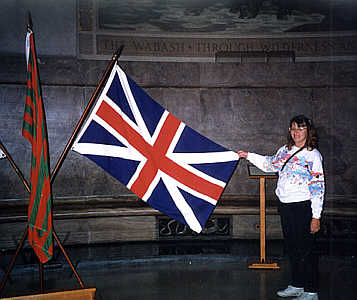
1779 British flag - beautifully demonstrated by Patty
but where is the red diagonal cross of St. Patrick?
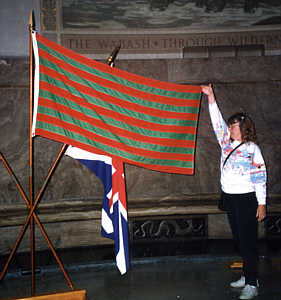
1779 American flag - again beautifully demonstrated by Patty
but why red and green stripes?
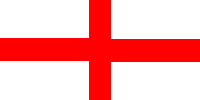
|
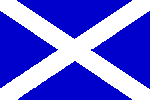
|
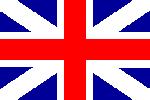
|
| St George | St Andrew | Union Flag of 1606 |
By 1707 this flag was known as the "The Union" and was flown from the Royal Navy's mastheads. It was also flown from a jackstaff, a small flag pole at the bow of a ship and it was from this that it probably got its name of the "Union Jack". In 1801 Northern Ireland became part of the United Kingdom and St. Patrick's flag, a red diagonal cross on a white background, was added to the Union Jack by King George III. In 1779 there was another two years to go before St. Patrick's flag was added and that's why the flag in the memorial is as it is.
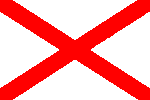 |
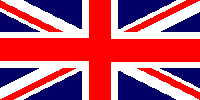 |
| St Patrick | Union Jack of 1801 |
But what about the other country in the United Kingdom, Wales? Because when the first Union Flag was created in 1606, Wales was already united with England. Wales was conquered by England in the 13th Century and in 1536, under Henry VIII, the Act of Union officially joined England and Wales. Therefore Wales is represented by the English flag instead of the Welsh dragon or the yellow cross on a black background of St. David.
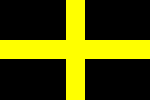 |
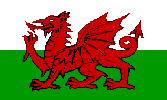 |
| St David | Welsh flag |
During the American Revolutionary War (1777 - 1783) and the American Civil War (1861 - 1865) American flags abounded, most symbolised the original 13 states.
Although the first flag act of 1777 stipulated that the United States flag should be made of 13 stripes, alternating red and white, many other variations were used, as in the case of George Rogers Clark's red and green stripes.
One website I found, the California Young Marines, says that "The United States Flag is the third oldest of the National Standards of the world; older than the Union Jack of Britain or the Tricolor of France." Which I find rather odd. The American First flag act was passed in 1777 the British Union flag had already been in use since 1606. If they mean that the proportion and order of the flag, then this was made law in the US in 1912, whilst the British was finalised in 1801. Things get worse if they mean the current form of the flag, as Hawaii, a Territory of the United States since 1900, was admitted into the Union on 21st August 1959 and the 50th star added on 4th July 1960. The site can be thought of as being right in the sense that the British Union Jack has NEVER been adopted by British law, in the same way that we don't have a written British Constitution.
Websites :-
Vincennes, Fort Sackville, George Rogers Clark etc.
The Fall of Fort Sackville - Part of the Indiana Historical Bureau site
George Rogers Clark National Historical Park
Spirit of Vincennes Rendezvous
Flags
3D Flags - Animated flags of the world
American Flag and Gift - although a commercial site it contains a lot of facts and useful images
Animated Flags - animated flags of the world
Betsy Ross and the American Flag from USHistory.org
Composition of the British Union Jack from the History of US Naval Uniforms and Insignia
Drawing the Union Jack Accurately
Flag Day - a history of the US flag
Flagline - a commercial site, more of use if you want to purchase a flag
Flag Institute - a huge site about the flags of the world
Flag of the United States of America
Flags of the World - a huge, useful site
Flags at the George Rogers Clark National Historical Park
Guide to American Flags from the University of Oklahoma College of Law , lots of historical information on this site
History of the Union Jack from the British Monarchy official website
Hornswoggled - an alternative to the familiar US flag?
It's a Grand Ol' Flag - a history of the US flag
Making of the Union Jack from English Customs and Traditions by Woodlands Junior School
Sons of the Revolution in California - a huge site with a history of American flags
Unofficial American Flag Homepage
US Flag History from Bob Hunt's Home Page
US Flag History from the California Regiment of Young Marines
US Flags from Vexillology - the study of flags site
World Flag Database a huge site
Miscellany | 6 Degrees | Afghanistan | Biological Warfare | DW Canoe Race | The Donner Party | The Eastland | The Edmund Fitzgerald | K Class Submarines (Page 1), (Page 2) | McClellan | Murder | Plagiarism | Product Placement | Racial Insults | Ten Plagues of Egypt | UK & US Flags
HomePage | Optical Illusions | War Stories | QBasic | Dads Navy Days | Bristol | Bristol, USA | Bristol, Canada | Terre Haute | Miscellany | Web Stuff | About Ray | Site Map | Site Search | Messages | Credits | Links | Web Rings
This page created 21st November 2001, last modified 27th April 2005